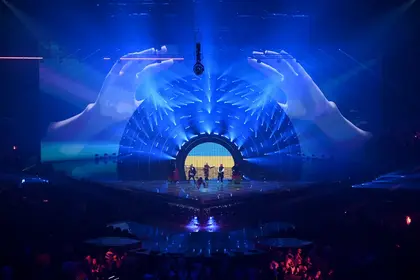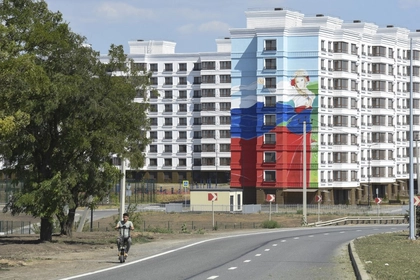There’s an ancient Chinese curse: “May you live in interesting times.”
In September, during a Kharkiv literary festival roundtable discussion, Ukrainian philosopher Vakhtang Kebuladze was asked how he saw the near future of his country. His response echoed the Chinese curse: “We will live poorly, but it will be interesting.”
JOIN US ON TELEGRAM
Follow our coverage of the war on the @Kyivpost_official.
Cultural life in Ukraine since Russia’s massive attack on Feb. 24 has been anything but dull. Ukrainians have coalesced like never before, and the arts have played a special role in bringing ordinary people together in times of darkness, while conveying the strength of a nation.
Music – from the bomb shelters to the international stage
Since the very first days of the full-scale invasion, music has brought people together.
One of Ukraine’s biggest rock stars, Sviatoslav Vakarchuk, traveled around the country to lift people’s spirits in train stations and on underground metro platforms doubling as bomb shelters, and in the dugouts at the front with the troops.
As the distinctive lead vocalist of band Okean Elzy, Vakarchuk’s songs have become something of a soundtrack for Ukrainian resistance ever since the 2014 Revolution of Dignity.
Meanwhile, Ukrainian pop music received a rousing reception at the Eurovision Song Contest in May, where the Kalush Orchestra won with its haunting rap lullaby “Stefania.”

IMF Approves $1.1 Billion Loan Disbursement to Ukraine Before Trump Inauguration
Within months of the attack, the world came to understand the importance of song to Ukrainians’ fundamental way of life.
As the end of the year approached, even New York’s Carnegie Hall became a venue celebrating Ukrainian music. The venerable theater hosted the centennial of the first performance there of “Shchedryk,” or “Carol of the Bells” as it is known internationally. Composed by Mykola Leontovych, who was murdered by the Soviets in 1921, the song is based on an ancient pre-Christian folk tune.
Also at Carnegie Hall, renowned French pianist Valentin Silvestrov, lauded as Ukraine’s greatest living composer, performed several of his “Bagtelles.”
So, whether through rock or rap, folk or classical, Ukraine’s music scene has inspired its own people to resist, and the world to come to provide its support.
Turning bread into stone – therapy for the soul
Turning to the visual arts, some Ukrainians have taken to the international stage with artworks reflecting and capturing their plight.
As part of a satellite exhibit in Venice, Zhanna Kadyrov created “Palianytsia” (the Ukrainian word for a particular loaf of bread). The word itself is considered so difficult for Russians to pronounce without an accent, that it came to be used as a password in times of anti-Russian resistance. The artist “transubstantiated this idea into a series of neatly sliced ‘loaves’ made out of stones rounded by rivers in the Carpathian Mountains, where she had been sheltering from the conflict.”
At the Venice Binennale, artist Pavlo Makov displayed a work titled “Fountain of Exhaustion. Aqua Alta.”
Besides those artists who managed to get a spot at one of the world’s premier art exhibitions. Kyiv and other Ukrainian cities have been bristling with artistic activity.
Perhaps the most poignant works are those painted on the sides of buildings, such as those of anonymous British artist Banksy, who came to Ukraine to portray his own visual messages about Russian invasion. Similarly, artists painted sunflowers on piles of vehicles riddled with bullet holes and left destroyed by a Russian attack in Irpin.
Waiting for the word
History is already in the making and tomorrow’s literary works about the war are likely still churning through the minds of writers currently serving at the front. The number of stories already being told – of heroism and escape – are awe-inspiring and they will continue to emerge in the coming month and years, both through the written word and on screen.
Novelist Artem Chapeye saw his story, “The Ukraine,” published in an April issue of The New Yorker, one of the most prestigious English-language weekly publications for fiction writers.
Chapeye is now serving in the army and has given interviews from the front.
Shorter works by poets have been doing the rounds at readings all over the country and abroad. And one of Ukraine’s best-known poet-novelists, Serhiy Zhadan, even toured Europe with his band, Zhadan i Sobaky (Zhadan and the Dogs) to raise funds for the Ukrainian Armed Forces.
It is just a matter of time before this generation of writers and their spirit of resistance solidifies its place in the canon of Ukrainian and world literature.
Unfortunately, one Ukrainian poet and author of children’s books, Volodymyr Vakulenko, won’t be able see his wartime works reach his intended audience. Vakulenko was abducted by Russians from his village near Izyum. His murdered body was found among the 447 corpses at the mass grave site discovered by Ukrainian soldiers when they liberated the city in September.
To laugh and to fight
One of the fastest growing art forms in Ukraine has been stand-up comedy. Ukrainians love to laugh, and they have used humor not only to survive, but as a weapon by which to bait their enemy into the many blunders that have allowed Ukraine to get the upper hand in this war.
As the philosopher Kebuladze said, “We make fun of them, and they hate it.”
And yet, perhaps the most important cultural achievement Ukraine has managed over the course of the year has been simply to fight, survive, and win.
That “will” to fight was displayed in the boxing ring by heavyweight champion Oleksander Usyk, who beat a much bigger and stronger opponent in Anthony Joshua by using speed and skill to his advantage.
While some may claim boxing is not an art form, connoisseurs of the “sweet science” would beg to differ. And anyone who has seen the heavyweight champion dance will agree that Usyk is very much an artist.
Lost performers
Ukraine has sadly lost a number of incredible artists this year as a direct result of Russia’s war.
Ballet dancer Artem Datsyshyn, 43, died from his injuries following a Russian shelling attack that happened just two days into the invasion. Another, Oleksandr Shapoval, was killed in battle at the age of 47, fighting for his country in Donetsk.
Also killed was the beloved actress Oksana Shvets, who succumbed at the age of 67 when a Russian rocket hit her Kyiv apartment building.
Poised for a renaissance?
Taking lessons from history, such periods of societal difficulty can often lead to a flourishing of the arts.
To quote Harry Lime, the character played by Orson Welles in “The Third Man” (1949): “In Italy for 30 years under the Borgias, they had warfare, terror, murder, and bloodshed, but they produced Michelangelo, Leonardo da Vinci, and the Renaissance. In Switzerland, they had brotherly love, they had five hundred years of democracy and peace, and what did that produce? The cuckoo clock.”
One must hope Ukraine will not only live through this year and the next, but that its culture will thrive and flourish as it passes through this current crucible of war.
You can also highlight the text and press Ctrl + Enter







